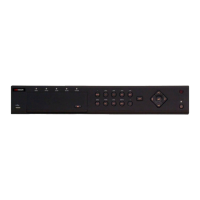Digital Video Recorder User Manual
317
• HTTP: Acronym for Hypertext Transfer Protocol. A protocol to transfer hypertext request
and information between servers and browsers over a network
• PPPoE: PPPoE, Point-to-Point Protocol over Ethernet, is a network protocol for encapsulating
Point-to-Point Protocol (PPP) frames inside Ethernet frames. It is used mainly with ADSL
services where individual users connect to the ADSL transceiver (modem) over Ethernet and
in plain Metro Ethernet networks.
• DDNS: Dynamic DNS is a method, protocol, or network service that provides the capability
for a networked device, such as a router or computer system using the Internet Protocol
Suite, to notify a domain name server to change, in real time (ad-hoc) the active DNS
configuration of its configured hostnames, addresses or other information stored in DNS.
• Hybrid DVR: A hybrid DVR is a combination of a DVR and NVR.
• NTP: Acronym for Network Time Protocol. A protocol designed to synchronize the clocks of
computers over a network.
• NTSC: Acronym for National Television System Committee. NTSC is an analog television
standard used in such countries as the United States and Japan. Each frame of an NTSC
signal contains 525 scan lines at 60Hz.
• NVR: Acronym for Network Video Recorder. An NVR can be a PC-based or embedded system
used for centralized management and storage for IP cameras, IP Domes and other DVRs.
• PAL: Acronym for Phase Alternating Line. PAL is also another video standard used in
broadcast televisions systems in large parts of the world. PAL signal contains 625 scan lines
at 50Hz.
• PTZ: Acronym for Pan, Tilt, Zoom. PTZ cameras are motor driven systems that allow the
camera to pan left and right, tilt up and down and zoom in and out.
• USB: Acronym for Universal Serial Bus. USB is a plug-and-play serial bus standard to interface
devices to a host computer.
18.3 Troubleshooting
No image displayed on the monitor after the device is starting up normally.
Possible Reasons:
— No VGA or HDMI connections.
— Connection cable is damaged.
— Input mode of the monitor is incorrect.
Step 1 Verify the device is connected with the monitor via HDMI or VGA cable.
If not, please connect the device with the monitor and reboot.
Step 2 Verify the connection cable is good.
